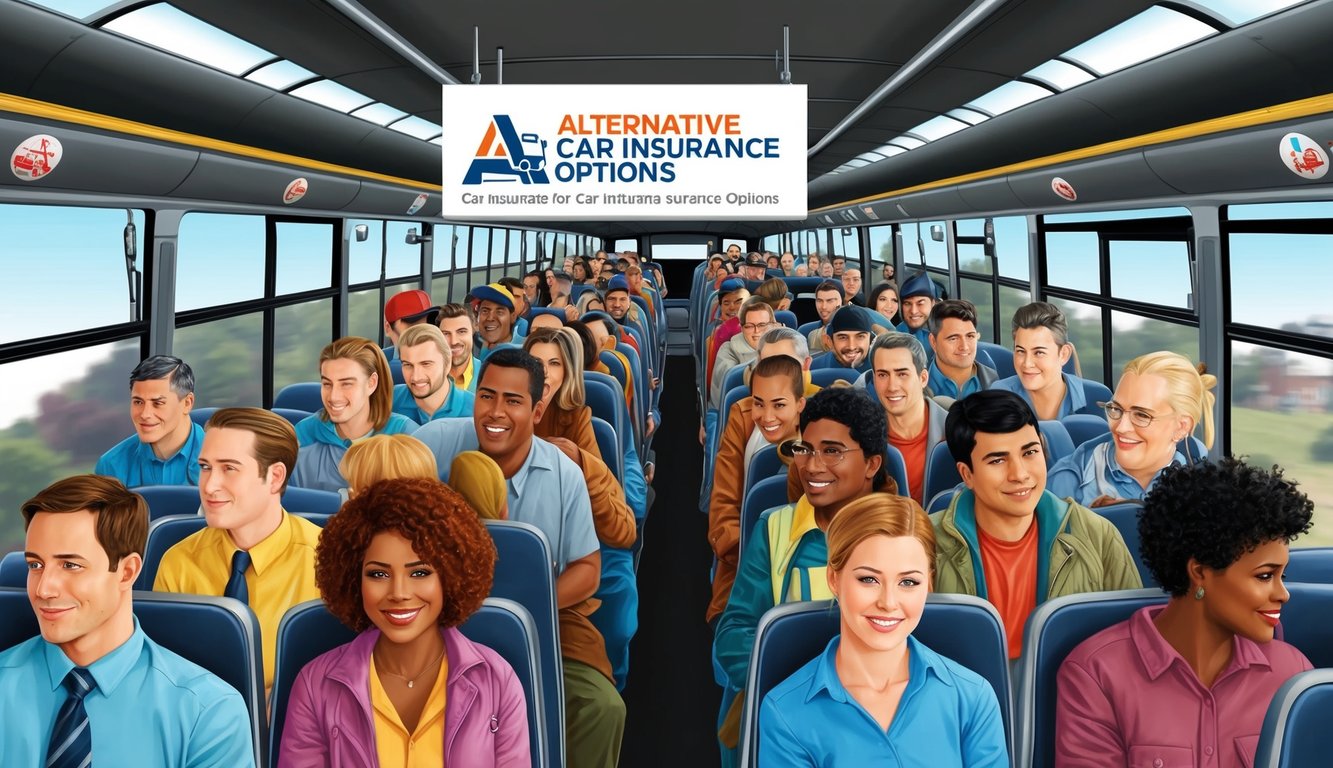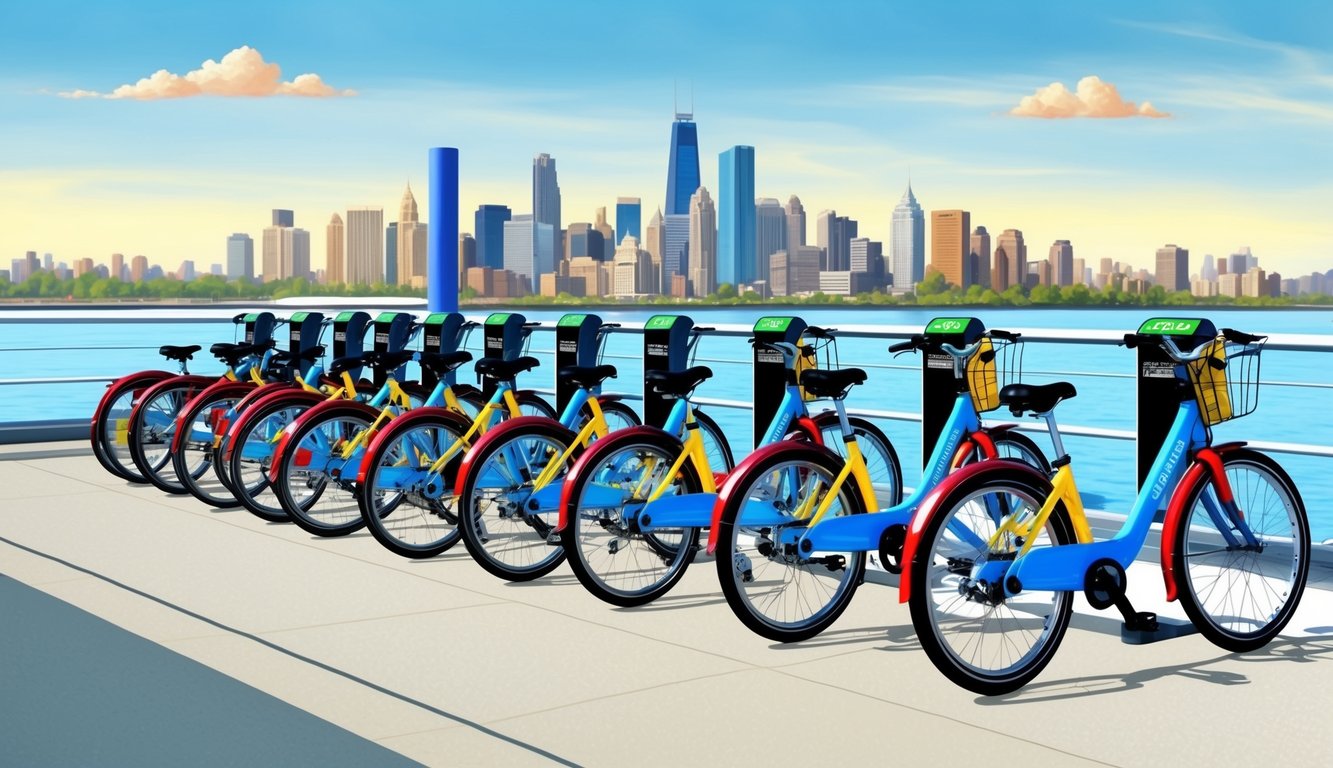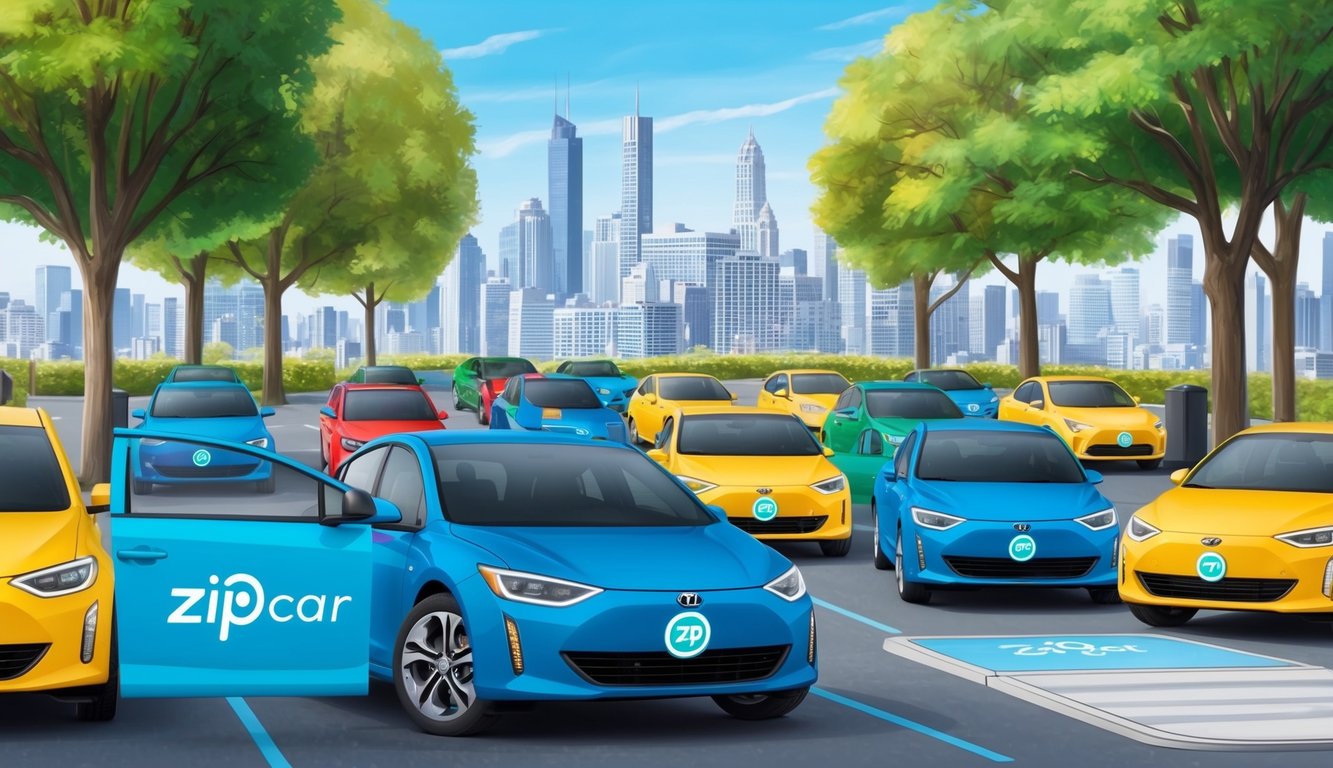Car insurance costs can be a significant burden on your budget.
Many drivers find themselves paying high premiums for coverage they may rarely use.
This article explores alternatives to traditional car insurance that could help you save money while still protecting yourself on the road.
You have options beyond standard auto insurance policies that may better suit your needs and financial situation. We’ll examine several alternatives, including surety bonds, self-insurance, and pay-per-mile programs.
By understanding these choices, you can make an informed decision about the best way to protect yourself and your vehicle without overpaying for coverage you don’t need.
1) Ride-sharing services like Uber and Lyft
Ride-sharing services offer a flexible alternative to traditional car ownership and insurance.
When you use Uber or Lyft, you don’t need to worry about maintaining a vehicle or paying for insurance coverage.
These platforms provide insurance coverage for riders during trips.
This means you’re protected without the ongoing costs of a personal auto policy.
For occasional transportation needs, ride-sharing can be more cost-effective than owning a car.
You only pay for the rides you take, avoiding expenses like parking, fuel, and vehicle depreciation.
Ride-sharing services are widely available in urban areas, offering convenience and accessibility.
You can request a ride with just a few taps on your smartphone, often with shorter wait times than traditional taxis.
If you’re considering becoming a ride-share driver, be aware that you’ll need special rideshare insurance.
Personal auto policies typically don’t cover commercial use of your vehicle.
Many insurance companies now offer rideshare endorsements to extend coverage during the periods when you’re waiting for a ride request.
This helps fill the gap between personal and commercial coverage.
While ride-sharing services can be a cost-effective transportation option, consider your specific needs and usage patterns.
For frequent travelers or those in areas with limited ride-sharing availability, other alternatives might be more suitable.
2) Public transportation passes

Public transportation passes offer a cost-effective alternative to car ownership and insurance.
These passes typically provide unlimited access to buses, trains, and other local transit options for a fixed monthly or annual fee.
Many cities offer discounted rates for students, seniors, and low-income residents.
This can make public transit an even more affordable option for those looking to save money on transportation costs.
Passes in some cities are particularly budget-friendly.
Places like Bremerton, Washington, and Bridgeport, Connecticut have relatively moderate costs for city-wide passes despite being fairly wealthy areas.
You can often save money by purchasing longer-term passes.
For example, an annual pass may offer significant savings compared to buying monthly passes throughout the year.
Some employers provide subsidized or free public transit passes as part of their benefits package.
This can result in substantial savings for you, potentially eliminating transportation costs entirely.
Public transit passes also eliminate other car-related expenses.
You won’t need to worry about parking fees, fuel costs, or vehicle maintenance when relying on public transportation.
Consider trying public transit on a trial basis before fully committing.
You can start by using it for your work commute one day a week or for weekend trips to gauge its convenience and cost-effectiveness for your lifestyle.
3) Car rentals from companies like Hertz
Car rental companies offer a flexible alternative to owning a vehicle.
You can rent a car for short periods, from a day to several weeks, depending on your needs.
Major rental companies like Hertz, Enterprise, and Avis have locations across the country.
This makes it convenient to pick up and drop off vehicles in different cities.
Rental rates vary depending on factors such as car type, rental duration, and location.
Weekend rates are often lower than weekday rates.
You can often find discounts through memberships or online booking.
When renting, you’ll need to decide on insurance coverage.
Your personal auto insurance may cover rentals, so check your policy.
Credit cards sometimes offer rental car protection as well.
Third-party insurance options are available if you want additional coverage.
These can be more affordable than the insurance offered by rental companies.
Loyalty programs allow you to earn points on rentals.
These points can be redeemed for free rental days or upgrades on future rentals.
Some rental companies offer one-way rentals, allowing you to pick up a car in one location and return it to another.
This can be useful for road trips or relocations.
Remember to inspect the car before driving off and report any existing damage.
This helps avoid disputes when returning the vehicle.
4) Bicycle-sharing programs like Citi Bike

Bicycle-sharing programs offer an affordable alternative to car ownership and insurance.
These systems allow you to rent bikes for short trips around the city.
Citi Bike in New York City is a prime example of a successful bike-sharing program.
Similar services exist in many major cities worldwide.
To use a bike-sharing program, you typically need to sign up for a membership or purchase a day pass.
This gives you access to bikes stationed throughout the city.
When you’re ready to ride, you can unlock a bike using a smartphone app or membership key.
Ride to your destination and return the bike to any docking station in the network.
Pricing varies by program, but it’s generally much cheaper than car ownership.
For example, a single ride on Los Angeles’ Metro Bike Share costs $1.75 for 30 minutes.
Many programs offer annual memberships for frequent users, which can further reduce costs.
These often provide unlimited short rides for a fixed yearly fee.
Bike-sharing is ideal for short trips and commutes in urban areas.
It eliminates the need for vehicle storage and maintenance.
You also don’t need to worry about parking fees or fuel costs.
Plus, you get the added benefits of exercise and reduced environmental impact.
Keep in mind that bike availability can be limited during peak hours.
Weather conditions may also affect your ability to use the service comfortably.
5) Electric scooter rentals from Lime
Electric scooter rentals from Lime offer an affordable alternative to car insurance.
You can easily find these scooters in many cities worldwide.
To start using Lime scooters, you’ll need to download their app and create an account.
Once set up, you can locate and unlock nearby scooters using your smartphone.
Lime’s pricing structure typically includes an initial unlocking fee and a per-minute charge.
The unlocking fee usually ranges from $1 to $2, while the per-minute rate is between $0.15 and $0.30.
These rates may vary depending on your location.
Some cities might have additional fees or surcharges due to local regulations.
Lime scooters are ideal for short trips around the city.
They’re especially useful for commuting, running errands, or exploring your neighborhood.
You don’t need to worry about maintenance or storage costs.
Lime takes care of charging and maintaining the scooters.
Using Lime scooters can be more cost-effective than owning a car, especially if you only need occasional transportation.
You pay only for the time you use the scooter.
Keep in mind that Lime scooters have speed limits, typically around 15 mph.
This makes them suitable for urban areas but not for longer trips or highways.
Before riding, make sure to familiarize yourself with local traffic laws and safety guidelines.
Always wear a helmet and follow proper riding etiquette.
6) Carpooling with colleagues and friends

Carpooling offers a practical way to reduce your transportation costs.
By sharing rides with coworkers or friends, you can significantly cut down on fuel expenses and vehicle wear and tear.
When you carpool, you’ll split the costs of gas and parking among multiple people.
This can lead to substantial savings over time, especially for longer commutes.
Carpooling also reduces the number of miles you put on your vehicle.
Fewer miles driven means less frequent maintenance and potentially lower insurance premiums.
To start carpooling, reach out to colleagues who live near you or along your route to work.
You can also use ridesharing apps or websites to find compatible carpool partners.
Consider establishing a rotation schedule where each person takes turns driving.
This ensures fairness and distributes vehicle wear evenly among participants.
When determining costs, you can use the government mileage rate as a guideline and split it among passengers.
This method provides a fair way to calculate expenses.
Carpooling not only saves money but also reduces stress by sharing driving responsibilities.
You can use the commute time to relax or socialize with your carpool companions.
Remember to check with your insurance provider about any coverage implications of carpooling.
Some policies may require adjustments to ensure proper protection for all parties involved.
7) Subscription-based alternatives like Zipcar

Subscription-based car services offer a flexible alternative to traditional car ownership and insurance.
Zipcar is a popular option that provides access to vehicles on-demand without the need for long-term commitments.
With Zipcar, you can rent vehicles by the hour or day, allowing you to pay only for the time you actually use the car.
This can be more cost-effective than maintaining a personal vehicle and paying for insurance year-round.
Zipcar membership typically includes insurance coverage, gas, and maintenance costs in the rental fee.
This bundled approach can simplify your transportation expenses and potentially save you money compared to separate car payments and insurance premiums.
The service is particularly useful if you live in an urban area where you don’t need a car daily.
You can reserve a vehicle when needed for errands, day trips, or occasional longer journeys.
While Zipcar is well-known, other car-sharing services like Getaround and Turo offer similar subscription-based models.
These platforms may provide different vehicle options or pricing structures that could better suit your specific needs.
Consider your driving habits and frequency when evaluating subscription-based alternatives.
If you only need a car occasionally, these services can offer significant savings compared to full-time car ownership and insurance costs.
8) Walking for short distances
Walking is a simple yet effective alternative to driving for short trips.
You can save money on gas, insurance, and parking fees by choosing to walk instead of drive.
Walking offers health benefits too.
It’s a low-impact exercise that can improve your cardiovascular fitness and help maintain a healthy weight.
For distances under a mile, walking can be just as quick as driving when you factor in parking and traffic.
You’ll avoid the hassle of finding a parking spot and can often take shortcuts not available to cars.
Walking allows you to engage more with your surroundings.
You might discover new local businesses or enjoy nature in your neighborhood.
In urban areas, walking can sometimes be faster than driving due to traffic congestion.
You’ll also contribute to reducing traffic and emissions in your community.
To make walking more enjoyable, invest in comfortable shoes and weather-appropriate clothing.
Consider using a backpack or tote bag for carrying items.
Plan your routes to include sidewalks and pedestrian-friendly areas for safety.
Use crosswalks and obey traffic signals to ensure a secure walking experience.
Remember to stay hydrated, especially in warm weather.
Bring a water bottle on longer walks to keep yourself refreshed.
9) Using a motorcycle or moped

Switching to a motorcycle or moped can significantly reduce your transportation costs.
These vehicles are generally cheaper to purchase and maintain than cars.
Insurance for motorcycles and mopeds is often less expensive than car insurance. Moped and scooter insurance can cost as little as $4 to $6 per month, making it an affordable option for budget-conscious individuals.
Fuel efficiency is another major advantage.
Motorcycles and mopeds typically consume less gas than cars, helping you save money at the pump.
Parking is easier and often cheaper with these smaller vehicles.
You may find more available spaces and lower parking fees in urban areas.
Keep in mind that weather conditions can affect your ride.
You’ll need appropriate gear for different seasons and may need alternative transportation on very rainy or snowy days.
Safety is crucial when riding a motorcycle or moped.
Always wear a helmet and protective clothing, and consider taking a safety course to improve your skills.
Some states require insurance for mopeds and scooters, so check your local regulations before making the switch.
Even if it’s not mandatory, insurance can provide valuable protection.
10) Telecommuting or working from home

If you’re working from home, you may be able to reduce your car insurance premium.
Your vehicle usage has likely decreased significantly, which can lead to savings on your auto insurance.
Contact your insurance provider to update your annual mileage.
Many companies offer low-mileage discounts for drivers who use their cars less frequently.
You might also be eligible to remove coverage for commuting, further lowering your costs.
Some insurers provide specific policies for telecommuters.
These plans often include flexible options tailored to your new work-from-home lifestyle.
For example, you may find pay-per-mile insurance more suitable if you’re only driving occasionally.
Consider adjusting your deductible.
Opting for a higher deductible can lower your premium, but ensure you can afford the out-of-pocket expense if you need to file a claim.
Don’t forget to inquire about additional discounts.
Many insurance companies offer savings for various reasons, such as bundling policies or maintaining a clean driving record.
Make sure you’re taking advantage of all available discounts.
If your current insurer doesn’t offer satisfactory options, shop around. Compare quotes from different companies to find the best rates for your new driving habits.
You might be surprised by the potential savings when you switch providers.
Understanding Car Insurance Costs
Car insurance premiums are influenced by various factors and may include hidden fees.
Knowing what impacts your rates and being aware of additional charges can help you make informed decisions about your coverage.
Factors Affecting Premium Rates
Your driving record plays a significant role in determining your car insurance costs. Accidents and traffic violations can lead to higher premiums.
Age is another crucial factor, with younger and older drivers typically paying more.
The type of vehicle you drive affects your rates.
Expensive cars or those with high theft rates often result in higher premiums.
Your location matters too – urban areas generally have higher rates due to increased accident risks and theft.
Credit score can impact your insurance costs in many states.
Better credit often leads to lower premiums.
Your coverage choices also affect rates.
Higher liability limits and additional coverages like comprehensive and collision increase your costs.
Hidden Fees and Charges
Insurance companies may charge various fees beyond your base premium.
These can include:
- Policy fees
- Installment fees for monthly payments
- Cancellation fees if you end your policy early
- Late payment fees
Some insurers charge a fee for paper billing or mailing your insurance card.
Others may add a surcharge for high-risk drivers or those with certain types of violations.
Be aware of potential rate increases at renewal time. Factors like inflation and rising repair costs can lead to higher premiums, even if you haven’t had any claims or changes to your policy.
Alternative Options
Car insurance costs can be burdensome.
Fortunately, there are other transportation methods that can help you save money while still getting around effectively.
Ridesharing Services
Ridesharing services like Uber and Lyft offer a convenient alternative to owning a car.
You can request rides on-demand through smartphone apps, often at lower costs than traditional taxis.
These services are ideal for occasional trips or commutes.
You’ll avoid expenses like car payments, insurance, maintenance, and parking fees.
Ridesharing is particularly cost-effective in urban areas with high parking costs.
Many cities also offer carpooling options through these apps, further reducing per-person costs.
For frequent users, subscription plans can provide additional savings.
These typically offer discounted rates on a set number of rides per month.
Public Transportation
Public transportation systems provide an affordable and environmentally friendly alternative to car ownership.
Buses, trains, and subways offer regular service in many cities and towns.
Monthly passes can significantly reduce your transportation costs compared to car ownership.
Many transit systems offer discounts for students, seniors, and frequent riders.
Public transit eliminates worries about parking, traffic, and vehicle maintenance.
It also allows you to use travel time productively for reading, working, or relaxing.
In some areas, bike-sharing programs complement public transit, offering flexibility for shorter trips.
This combination can provide comprehensive coverage for your transportation needs without the burden of car ownership and insurance costs.
Evaluating Your Needs
Understanding your specific car insurance requirements is crucial for finding cost-effective alternatives.
This process involves analyzing your risk factors and determining the right balance between coverage and affordability.
Assessing Risk and Coverage
Start by evaluating your driving habits and personal circumstances.
Consider factors like:
• Your annual mileage
• The areas you typically drive in
• Your vehicle’s make and model
• Your driving record
These elements help determine your risk level and coverage needs.
For example, if you drive infrequently, you might opt for usage-based insurance to potentially lower costs.
Review your current policy.
Identify which coverages are essential and which you might forego.
Mandatory coverages vary by state, so research your local requirements.
Balancing Cost and Benefits
Compare different coverage options and their associated costs.
Look beyond the premium to understand the total financial impact.
Consider raising your deductible to lower monthly payments.
But, make sure you can afford the higher out-of-pocket expense in case of an accident.
Explore discounts you might qualify for, such as:
• Safe driver discounts
• Multi-policy bundles
• Good student discounts (if applicable)
Remember, the cheapest option isn’t always the best.
Weigh the potential savings against the risk of inadequate coverage.
Your goal is to find a balance that provides necessary protection without overpaying.






